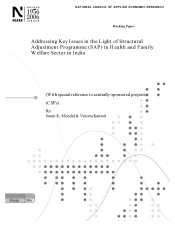Addressing Key Issues in the Light of Structural Adjustment Programme (SAP) in Health and Family Welfare Sector in India
Sameer Kumar Mondal
Vineeta Kanwal
March 2006
The cutback in public investment in the social sector, including health, is an inevitable consequence of the financial crises faced by both developed and developing countries since the late seventies. In India, the dismal performance and several deficiencies of public health services added fuel to the fire. Circumstances made it pertinent to mobilise additional resources from within the health sector itself, as contained in the structural adjustment programme, for financing the health sector. Thus, the involvement of private parties, NGOs, PRIs, co-operatives etc. for delivery of health services started gaining ground gradually. However, this trend is considered as a retreat from socialistic norms and counterproductive for the economically disadvantaged class. The policies including that of the World Bank and the recent ‘Indian Health Report (WHO) 2000’, now recognise the importance of investing in health and also providing a ‘safety net’ for the poor and vulnerable to promote economic development and reduce poverty. There is an urgent need to address several issues to revamp the entire health sector in India. The paper, apart from an extensive review of India’s health scenario also identifies the potential areas where further studies need to be undertaken for accelerating the reforms process in the desired direction.
Human Development and Data Innovation







